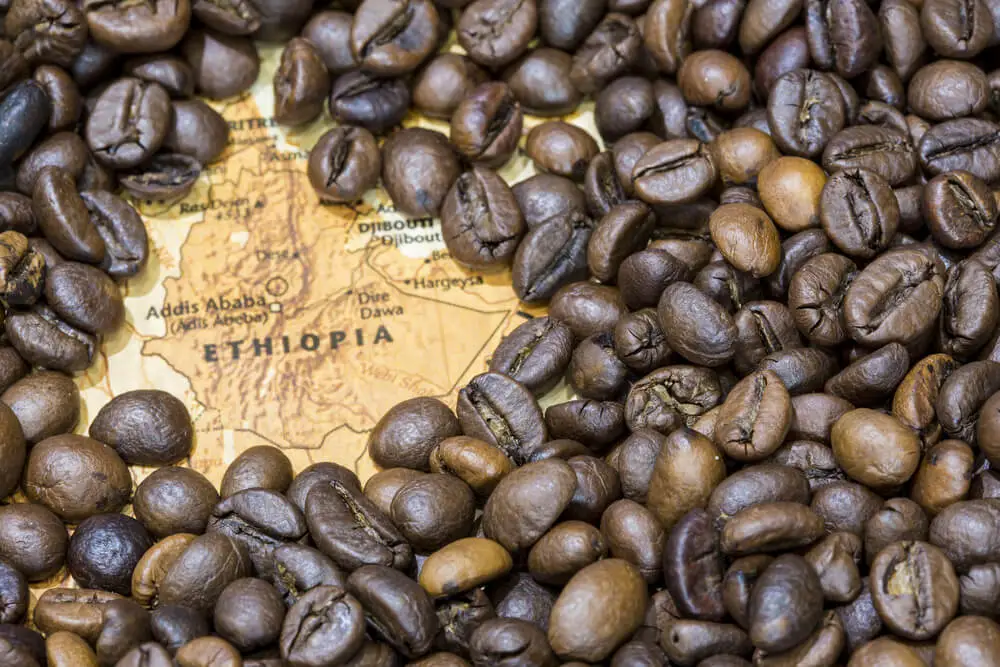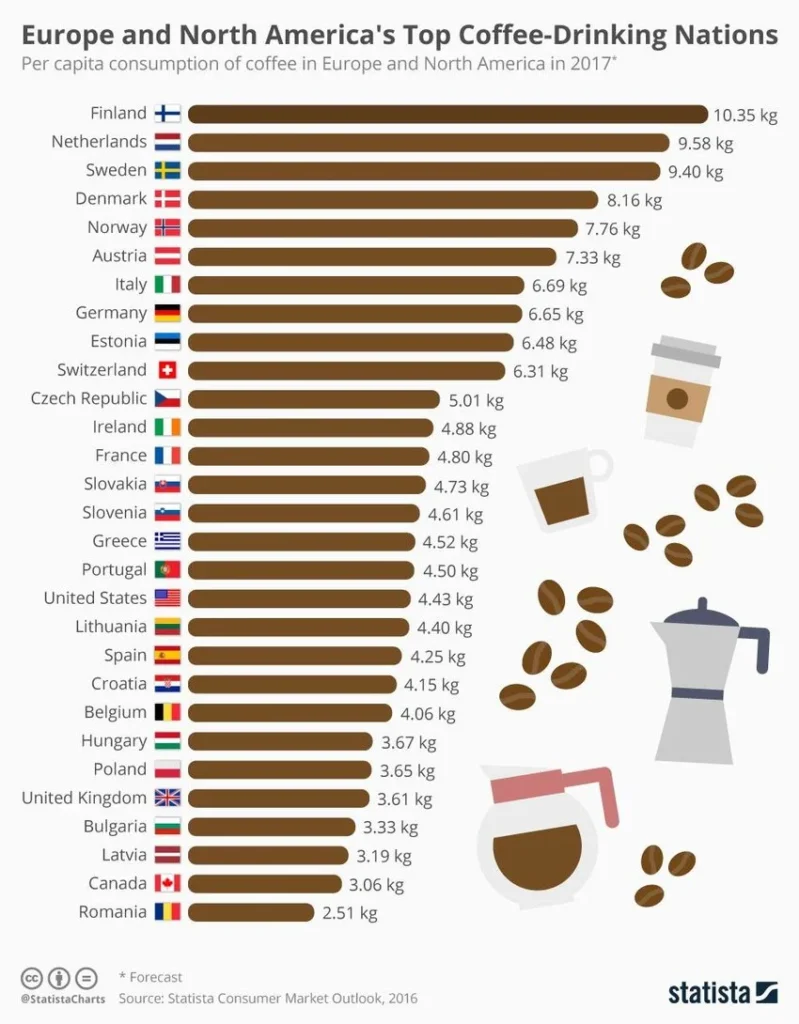Coffee isn’t just a drink—it’s an experience shared by me and people around the world. It’s the ritual that starts our mornings, the warm cup at a café with friends, and the product of countless hands working from farm to cup.
In this journey, I will explore you coffee’s story, its path across continents, and the ways it shapes our daily lives.
What is Coffee? The Fundamental Brew
Essentially, coffee is a liquid drink that is made from the roasted seeds – or, more loosely, beans – of the Coffee plant. These beans are found within red or purple fruits commonly known as coffee cherries.
Picked, processed, roasted, and ground, these beans release an aromatic, frequently energizing drink. The primary psychoactive ingredient in coffee is caffeine, a natural stimulant used by many to start their day or overcome an afternoon slump.
The Coffee genus contains many species, but most are not raised for commercial purposes. Coffee farming succeeds in the “Bean Belt,” a zone surrounding the equator, where steady temperatures and rain provide perfect conditions for growth
The trip from a healthy green cherry on a bush to the dark, scented grounds in your cup is long and complex, requiring much human labor and exact environmental conditions.
Two Core Types of Coffee (Beverage Preparations)
When we discuss about “types of coffee” in the end product context, So we talk about the different plant species and the different brewing methods.
Let me tell you about the most basic coffee brewing techniques. The most basic ones emphasize the versatility of coffee:
- Black Coffee: The purest form of coffee – plain brewed coffee and hot water.
It lays bare the intrinsic flavors, acidity, and body of the bean without additions. Many people enjoy it black to enjoy the subtleties added by origin, roast, and brewing method.
- Espresso: A strong coffee shot, espresso is produced by pressurizing hot water through finely ground coffee beans.
The technique pulls a thick, syrupy liquid capped with a reddish-brown foam known as crema. Espresso is the base for a wide variety of mainstream coffee drinks, such as lattes, cappuccinos, macchiatos, and Americanos, where it’s mixed with steamed milk, foam, or water.
Apart from these two, there is a world of coffee preparations, including pour-overs, French press, cold brew, Turkish coffee, and numerous regional variations, each providing a distinct sensory experience.
Etymology: Following “Coffee” Back to Its Roots
The word “coffee” has a compelling etymology, tracing its spread across cultures:
- Arabic Origins: The term’s origin is commonly derived from the Arabic word “qahwah” (قهوة). Initially, “qahwah” referred to a type of wine or any other intoxicating beverage. As coffee’s stimulating effects became known, the term was applied to this new drink that also offered a certain “exhilaration.”
- Turkish Adaptation: In the Arab world, coffee spread to the Ottoman Empire, where the name changed to “kahve” (قهوه). The Turks helped make popular the coffee houses, which became important centers of intellectual and social life.
- Dutch Influence: European commerce introduced coffee to the Netherlands, and the Dutch used “kahve” as “koffie.” The Dutch East India Company was instrumental in spreading coffee beans across Europe and to their colonies.
- English Adoption:Finally, early in the 17th century, the English adopted the borrowed Dutch word and added “coffee” to the dictionary, where it has remained to this day.
This linguistic journey reflects the historical path of coffee from its East African origins through the Middle East to Europe and the world.
Rich History of Coffee: From Goats to Global Staple
The history of coffee is filled with storied and documented facts, starting in ancient Ethiopia:

The Kaldi Legend (c. 9th Century AD):
The most popular origin legend is that of Kaldi, an Ethiopian goat herder. He noticed his goats got extremely energetic, practically “dancing,” after consuming red berries from a particular tree. Kaldi himself also tasted the berries and felt the same energizing effect.
He shared his discovery with the local monastery, where the monks initially disapproved, burning the berries in a fire.
But the sweet smell of the roasted beans prompted the monks to remove the cinders, grind the pre-roasted beans, and dissolve them in boiling water to prepare the world’s first cup of coffee. They found that it helped them stay awake through long hours of prayer.
Spread to Yemen (c. 15th Century):
Coffee beans were transported from Ethiopia over the Red Sea to Yemen. Sufi mystics there cultivated coffee for its energizing effects and used it to remain awake for religious rituals and meditations. The port city of Mocha became an important hub for coffee exportation.
The Islamic World (15th-16th Centuries):
Coffee houses, referred to as kaveh kanes, appeared in urban centers such as Mecca, Cairo, and Istanbul. These were lively centers of discussion, music, chess, and information, occasionally raising the anger of authorities because they were suspected of engaging in political debate.
Arrival in Europe (17th Century):
Venetian traders introduced coffee to Europe around the early 17th century. Initially, they were welcomed with suspicion and even referred to as “the bitter invention of Satan” by certain clergy.

According to legend, Pope Clement VIII tasted it and, finding it delicious, blessed it papally. Coffee houses quickly made in European capitals like London, Paris, and Vienna and became centers for social life, trade, and intellectual work during the Enlightenment.
Global Expansion (17th-18th Centuries):
European colonial states, especially the French and the Dutch, started growing coffee in their colonies in Asia, Caribbean, and South America. It was the start of coffee’s expansion as an international commodity with massive plantations emerging to meet growing demand.
It’s a journey that reflects the evolution of coffee from a local novelty to an all-time favorite beverage and a pillar of global commerce.
“Coffee” in Other Languages: A Tribute to Global Popularity
The global popularity of coffee is found in the number of languages that have adapted a variation of the term, frequently reflecting its Turkish and Arabic origins:
| French | café |
| German | Kaffee |
| Spanish | café |
| Italian | caffè |
| Portuguese | café |
| Dutch | Koffie (the origin of the English name) |
| Russian | kofe (кофе) |
| Japanese | kōhī (コーヒー) |
| Chinese (Mandarin) | kāfēi (咖啡) |
| Turkish | kahve |
| Arabic | qahwah (قهوة) |
| Greek | kafés (καφές) |
| Swedish | kaffee |
This diversity of language serves to strengthen coffee’s international status, a product crossing cultural and geographical lines.
Coffee: Essential Facts and Figures
Behind the statistics on coffee is a picture of phenomenal social and economic influence:
Second Most Traded Commodity:
Coffee is often referred to as the second most valuable legally traded commodity in the world, after crude oil, reflecting its too much presence in global commerce.
Global Value of Industry:
The world coffee industry is valued at more than $100 billion a year. This is inclusive of cultivation, processing, trade, roasting, retailing, and related services.
Average Daily Consumption:
With 2.25 billion cups of coffee consumed worldwide every day, it is one of the most consumed beverages in the world.
Economic Impacts on Exporting Countries:
Exports of coffee for most developing countries are a major source of earnings from abroad and jobs. Coffee is a source of living for millions of farmers and their families.
For example, coffee in Ethiopia is a source of export earnings and provides employment for millions.
Largest Consumers:
The production countries are generally within the Global South, the per capita biggest consumers are typically Scandinavians (Denmark, Finland, Norway, Iceland, Sweden), and other Europeans. The United States is the single largest market by volume.
Employment:
The coffee industry employs an estimated 25 million individuals worldwide, from production to distribution and retail.
These figures highlight coffee’s position not only as a beverage, but also as a central column of the world economy and a significant employer.


Pingback: Coffee Beans: From History to Health - ibobeans.com
Pingback: Can You Put Honey in Coffee? Discover its natural Benefits,tips and Delicious taste - ibobeans.com
Pingback: Top Iced Coffee Recipes and Tips to Stay Cool and Energized | ibobeans - ibobeans.com
Haha, caught me in the loop! Thanks for the 10/10 — I’ll take the recursion as a win. Let me know if you want the next level comment… or should we break free?
Thanks for the iced coffee love! ☕❄️ You’re so right—quick, customizable, and way cheaper than the café line. But wait till you try using that leftover iced coffee in a DIY face scrub—exfoliates like a dream and gives that natural glow! (Full recipe in the post ) What’s your go-to iced coffee twist?